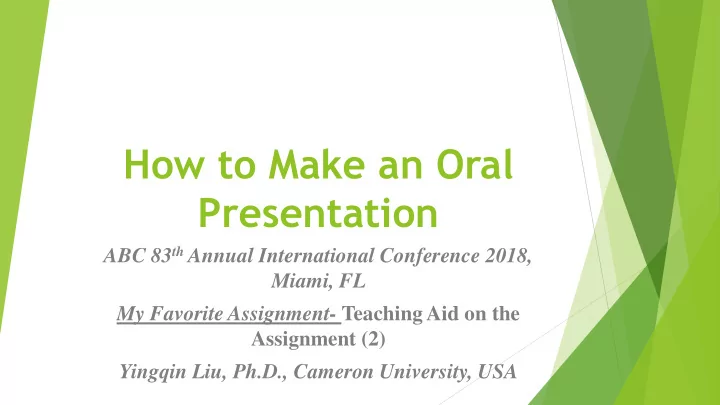

How to Make an Oral Presentation ABC 83 th Annual International Conference 2018, Miami, FL My Favorite Assignment- Teaching Aid on the Assignment (2) Yingqin Liu, Ph.D., Cameron University, USA
Chapter 21 Making Oral Presentations Four Types of Oral presentations 1. Impromptu- without advanced notice 2. Extemporaneous- speech done without any preparation or practice 3. Scripted- read a text written in advance 4. Memorized – speak without notes or a script
You will deliver presentations to four types of audiences 1. clients and customers 2. coworkers/ colleagues in your organization 3. fellow professionals at technical / academic conferences 4. the public
Preparing an oral presentation consists of five steps: 1. Analyze the speaking situation . 2. Organize and develop the presentation. 3. Prepare the presentation graphics . 4. Choose effective language . 5. Rehearse the presentation .
Here is the typical time allotment in a 10-minute presentation : Task Time (minutes) Introduction 1 Body First major point 2 Second major point 2 Third major point 2 Conclusion 1 Questions 2
Follow these four guidelines when concluding a presentation 1.Announce that you are concluding. 2.Summarize the main points. 3.Look to the future . 4.Invite questions politely .
An effective graphic has five characteristics : • It presents a clear, well-supported claim. • It is easy to see . • It is easy to read. • It is simple . • It is correct.
When planning your graphics, consider four aspects of the speaking situation 1. length of the presentation 2. audience aptitude and experience 3. size and layout of the room 4. equipment
Select from the five basic media for presentation graphics: 1.computer presentation 2.overhead projector 3.chalkboard o r other hard writing surface 4.Objects ( artifacts) 5.handouts
There are two reasons to choose effective language for a presentation : • Listeners can’t go back to listen again to something they didn't understand. • Because you are speaking live , you must maintain your listeners’ attention , even if they are hungry or tired or the room is too hot.
Use language to signal three kinds of presentation elements • advance organizers • summaries • transitions
Follow these three guidelines for using memorable language : • Involve the audience. • Refer to people , not to abstractions. • Use interesting facts , figures, and quotations.
Concentrate on three aspects related to delivering a presentation • Calm your nerves. • Use y our voice effectively. • Use your body language effectively.
Think about these six points to help calm your nerves: • You are much more aware of your nervousness than the audience is. • Nervousness gives you energy and enthusiasm. • After a few minutes, your nervousness will pass. • You are prepared. • The audience is there to hear you, not to judge you. • The audience is made up of individual people who happen to be sitting in the same room.
Try these four techniques to release nervous energy: • Walk around. • Go off by yourself for a few minutes. • Talk with someone for a few minutes. • Take several deep breaths, exhaling slowly.
Pay attention to five aspects of vocalizing : • volume • speed • pitch • articulation • nonfluencies
Follow these four guidelines when facing an audience: 1. Maintain eye contact. 2. Use natural gestures . 3. Don’t block the audience’s view of the screen. 4. Control the audience’s attention .
Follow these three tips for presenting to a multicultural or multilingual audience • Hire translators and interpreters if necessary. • Use graphics effectively to reinforce your points for nonnative speakers. • Be aware that gestures can have cultural meanings .
Be prepared for these four problems you might encounter in answering questions : • You’re unsure everyone heard the question. • You don’t understand the question . • You have already answered the question during the presentation. • A belligerent member of the audience rejects your response and insists on restating his or her original point.
The End Courtesy to Technical Communication 11 th edition by Mike Markel
Recommend
More recommend